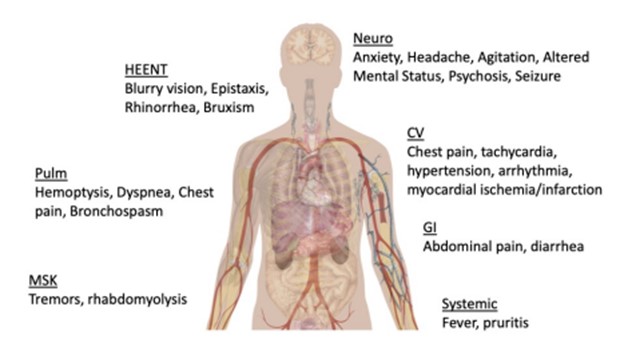A nurse is assessing a client who is experiencing acute cocaine toxicity. Which of the following findings should the nurse expect?
Hypothermia
Hypotension
Tremors
Respiratory depression
The Correct Answer is C
Tremors: This choice is correct. Tremors or muscle twitching can be expected in a client experiencing acute cocaine toxicity. Cocaine is a central nervous system stimulant that can cause overstimulation of muscles, resulting in tremors.
Incorrect:
A- Hypothermia: This choice is incorrect. Acute cocaine toxicity is associated with an increase in body temperature (hyperthermia) rather than a decrease (hypothermia). Cocaine is a stimulant that can cause the body to overheat, leading to hyperthermia, which is a dangerous condition that requires immediate medical attention.
B- Hypotension: This choice is incorrect. Cocaine is a stimulant that increases blood pressure and heart rate, leading to hypertension (high blood pressure), not hypotension (low blood pressure). Hypertension is a common cardiovascular effect of cocaine use.
D- Respiratory depression: This choice is incorrect. Respiratory depression, which is a slowing of the respiratory rate and depth, is more commonly associated with depressant drugs like opioids or benzodiazepines. As a stimulant, cocaine tends to have the opposite effect, leading to increased respiratory rate (tachypnea) and sometimes hyperventilation.

Nursing Test Bank
Naxlex Comprehensive Predictor Exams
Related Questions
Correct Answer is C
Explanation
Obtaining informed consent is a crucial step before administering electroconvulsive therapy (ECT). Informed consent ensures that the client is fully informed about the procedure, its potential risks and benefits, and any alternative treatments available. It allows the client to make an autonomous decision regarding their treatment.
The other responses are not accurate:
A- "ECT is an effective treatment for personality disorders." While ECT may be used in certain cases of severe mental illness, it is not primarily indicated for personality disorders.
B- "It is a myth that clients experience seizures during ECT." Seizures are a common and expected effect of ECT. ECT involves the induction of controlled seizures under anesthesia.
D- "Should monitor the client closely for hypotension following ECT." While monitoring the client for various physiological changes is important, hypotension is not a primary concern following ECT. The nurse would typically monitor for potential adverse effects such as confusion, memory loss, headache, and muscle soreness.
Correct Answer is B
Explanation
Chronic stress can weaken the immune system, making individuals more susceptible to infections, including viral infections. This is because stress hormones such as cortisol can suppress the immune response, making it harder for the body to fight off pathogens. As a result, individuals experiencing chronic stress may be more prone to illnesses such as the common cold or flu.
Incorrect:
A- Hypotension: Hypotension, or low blood pressure, is not typically associated with chronic stress. In fact, chronic stress often leads to increased sympathetic nervous system activity, which can result in elevated blood pressure.
C-Increased cognitive awareness: Chronic stress affects cognitive function. You might find it challenging to concentrate, make decisions, or stay mentally sharp.
D- Increased energy: Chronic stress typically leads to a state of exhaustion and fatigue rather than increased energy. Prolonged stress can drain a person's physical and mental energy, resulting in feelings of fatigue, lethargy, and a lack of motivation.
Whether you are a student looking to ace your exams or a practicing nurse seeking to enhance your expertise , our nursing education contents will empower you with the confidence and competence to make a difference in the lives of patients and become a respected leader in the healthcare field.
Visit Naxlex, invest in your future and unlock endless possibilities with our unparalleled nursing education contents today
Report Wrong Answer on the Current Question
Do you disagree with the answer? If yes, what is your expected answer? Explain.
Kindly be descriptive with the issue you are facing.
